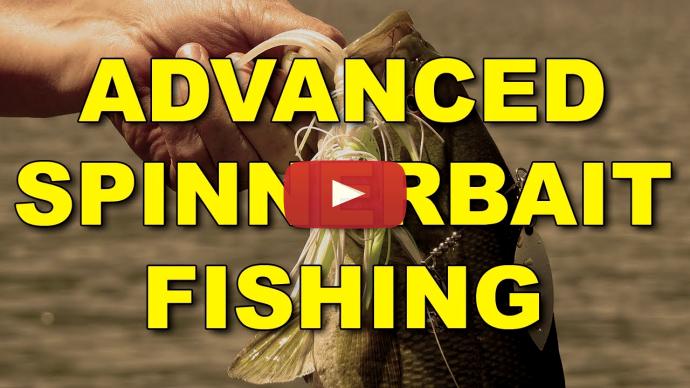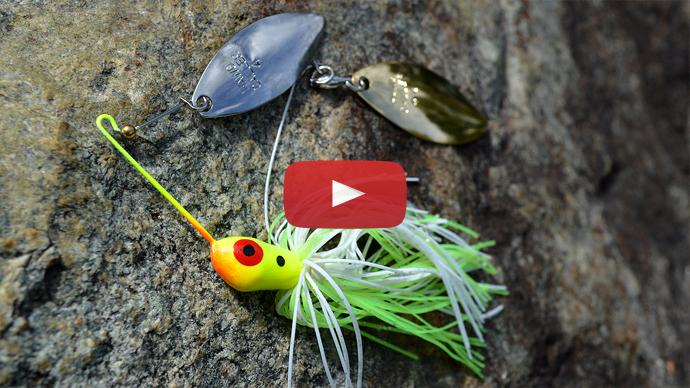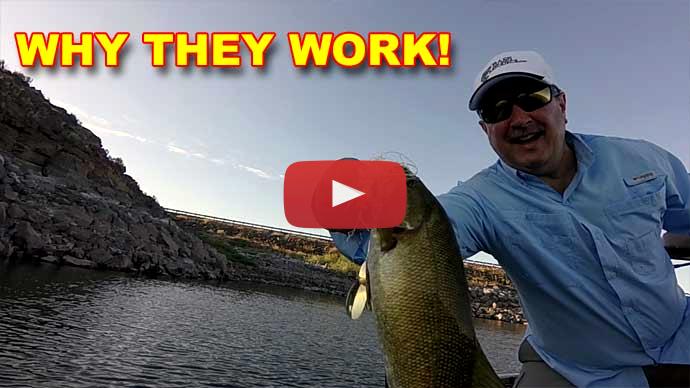All right, so you wanna know how to select the right spinnerbait and catch a lot of bass on them. We got a lot to cover, so I'm just gonna dive right into it. Spinnerbaits, for me, I've been fishing them since the '70s, and that is one of my favorite baits. So I've experimented a lot. A lot of guys, when they talk about spinnerbaits, they talk about size and color, and don't talk about much more. There's a lot more to talk about than that. So let's get size and color out of the way first.
Size, the bread and butter size everybody throws is a 3/8 ounce spinnerbait. You better have that in your tackle box. That seems to catch the most fish for a lot of guys. Nothing wrong with that. I've used them before. I've caught fish on them. I like to use heavier spinnerbaits. I use 3/4 ounce spinnerbaits. Not because I wanna slow roll it on the bottom, but because it's more versatile.
I can burn it back to the boat quickly and it won't lay over on the side as much. I can bring it back at a median speed. I can bring it back at a slower speed. Plus, I can throw it in a thick cover and it'll come out. That's what I really like about them. So there's a bit of a personal preference in there. But if you're new to spinnerbaits, be sure you at least have a 3/8 ounce spinnerbait. But it's okay to go a little bit heavier too.
As for color, white, white and chartreuse, and chartreuse are, like, the three main colors. White is, like, 90% of the time, I've fished all around this country throwing spinnerbaits and I've caught bass in a whole wide range of different types of body of water in different conditions, and I've caught 'em all on white spinnerbaits. I will use white and chartreuse when the water's really dingy, or if I'm targeting just small mouth, then I'll use straight-up chartreuse. They seem to like that bright flashy color.
Other than that, once in a while, I'll deviate from that and maybe throw little strands of red in there, or maybe dip the trailer in chartreuse to make it look a little more like a bluegill. So it's okay to experiment a little bit. One thing to keep in mind though is if you're night fishing using a spinnerbait, use a black color. It has the best silhouette in those dim light conditions, and it's easier for the bass to see. So a black or black and blue skirt is what I use for night fishing with spinnerbaits.
Okay, we got that out of the way. Now let's talk about blades. And again, some people will dive into blades and blade choices. There's more to it than that, and we'll get to that in a minute, but let's talk about blades, because that to me is really important. Blades are...basically, there's three main blades. There's a lot of different shapes out there, but the three ones you're gonna use the most are the Colorado, Indiana, and Willow Leaf blades.
Colorado blades provide the most lift. And what I mean by that is if you've got three identical spinnerbaits, and with each of those different blades, the Colorado...you retrieve those at the same speed, the spinnerbait with the Colorado blade's gonna ride highest in the water column followed by the Indiana and then followed by the Willow Leaf. So that's important to note. You would think, "Okay, if I wanna burn it back towards the surface, I'm gonna use Colorado." You could, but no, that's not what I do.
Colorado to me is perfect for slow rolling in deeper depths because it has more lift. It keeps the bait upright at a slower speed where the others will start to fall over. So Colorado blade, for me, is good wintertime fishing, it's good when I want to target deep structure in the summertime, and also puts out a good thump to it so the bass can hone in with their lateral lines better. So when the water's really dingy, cloudy, they can't see as much, that's a good time to use a Colorado blade. Or when you're fishing deeper, when the sunlight penetration isn't as much, Colorado blade gives off that vibration, the bass can find it easier. So that's good scenarios for Colorado.
The Indiana blades is, kind of, the jack of all trade. It's very versatile. I can burn a spinnerbait back with an Indiana. I can slow-roll it. I can do it at a moderate speed. They put out a little more flash than a Colorado, but not as much vibration. To me, I can fish 'em virtually anywhere. That's the blade I use the most on my spinnerbaits year-round just because of that versatility, because you never know if the spinnerbait...that's the cool thing is you can throw 'em in anything. You can throw 'em under docks, you can throw 'em in the bushes, you can throw 'em in the long weed lines and deep water. You can burn 'em back. You can do all that with the Indiana fairly well.
The Willow Leaf blades, they're named because they look like a willow leaf, but they also have a bait fish profile to them. And they give off the most amount of flash with the least amount of vibrations. So you have, like, a double Willow Leaf spinnerbait, well it looks like bait fish going through the water. It's really good to use them, like, when the bass are busting shad up on the surface, throw a Double Willow Leaf spinnerbait out into that frenzy and you're likely to get wax because it looks like bait fish that are trying to escape, trying to flee. Burn a spinnerbait that's got a Double Willow Leaf, and that's exactly what it looks like, a fleeing bait fish. And you can trigger those reaction strikes. So Willow Leaf can be really good for those situations.
Blade colors, people talk about those a lot. Really, for me, it's gonna be either gold or silver. I use gold most of the time, again, around the country because you either got, like, gold shiner or you've got perch or sunfish. They've all got some tints of gold in them, and that seems to get the most bites for me. A lot of guys, when the water's really clear or it's really sunny out like it is today, they like to use silver. And that puts out the most amount of flashing and bass further away can see it and it can call 'em in that way. So silver can be really good when you've got those situations. But those are the two main colors. I wouldn't experiment much beyond that.
Now, there's other things besides that. For example, trailers. A lot of guys like to put stingers, you know, trailer hooks on the back of spinnerbaits so that the bass are following it or short-striking the lure. I like to throw my spinnerbaits into the thick cover, like you do a jig. Don't be afraid to hook that thing right into the weeds, into submerged bushes. It'll come out. It is fairly weedless. You'd be surprised, that big wire, you know, arm blocks a lot of weeds. It actually works like a weed guard.
And so you put a trailer hook on the back, well, that, kind of, eliminates that, and you can't throw it into those weeds or over the tops of weeds or along the sides of the weeds where you're likely to bring back all that trash with that trailer hook. So I don't use trailer hooks. In fact, what I've noticed is if a bass is following the bait or it's short striking it, they're telling you something. Something's not quite right with it.
And I've found through experimentation that typically you change the blade color, that's what gets the strike. I can't tell you why, I just know it does. If I'm using a gold blade and I'm getting those follows, I flip over to a silver blade, boom, I get bites. It's a thing. So keep that in mind. So instead of using stinger hooks, I use trailers. Twin tail trailers are my favorites, the Zoom Twin Tail Trailers. There's other brands, you know, Big Bite Baits and Yomama Baits, you know, they make different twin-tailed trailers.
I just use white, straight-up white. Sometimes I'll dip 'em in chartreuse. Again, if I'm getting those following bass, I might dip little chartreuse or put a chartreuse trailer in there instead. Just a little slight color change, just a little variance, not a massive change. And that typically is what triggers those bites. But that trailer gives a little more bulk and a little bit more vibration. You can use 5-inch grubs as well. That's an excellent trailer. Some people use swimbaits, small 3-inch, 4-inch paddle tail swimbaits as trailers. There's no wrong here. So you can definitely use those, and that gives off a bigger profile, a little more vibration, something for the bass to focus in on and bite. I think that's a far more effective way for catching fish than using a trailer hook.
There's more to it than that though. The gear that people use, and especially the line, plays a critical role in spinnerbait success. So I'm gonna briefly talk about the rod and reel, but it's the line that I really wanna talk about. Rod and reel, for reel, you want to use a 7' to 7'3" medium heavy, fast action rod. That's, like, the ideal rod for spinnerbait fishing. You've got the backbone for setting a hook. Most of these spinnerbaits have a 4/0, a 5/0 thick hook, so you need a rod that's got a good strong backbone to set those hooks.
And you still have the tip for accuracy, especially the short underhand to cast. You need that tip to give you that accuracy. And you can also feel the vibration of the blades better with a fast action tip. Sometimes the bite is just a matter of the change of the cadence in the blade, especially the Colorado blade. But you'll feel that steady pulse and vibration and then it does a little hiccup. And oftentimes, that's just the bass bite. They come up behind it and they bite it and keep going at the same pace. But that blade, all of a sudden, you'll lose contact with that vibration of the blade to set that hook. So that rod is critical to success.
The reel, somewhere in the mid-6, is like a 6.5, 6.6:1 reel is ideal. You can go up to a 7, to a 7.4 if you like to bring 'em back real quick all the time, but that's gonna be difficult to do the slow rolling and slow presentations with a gear ratio that fast. So I can do it. I've done it with a 7.3:1 gear ratio. It's not impossible. You don't have to run up and buy a new reel if you don't have one in the 6 range just for spinnerbait fishing. But it's also those reels you can use for red, the other things too, and bass fishing. So it's not a bad idea to have a reel or two with that gear ratio available to you.
The line is what's important. A lot of guys think these days that braid is the answer and we're gonna use braid on everything. No, you're not. Braid is not a universal line, believe it or not. And matter of fact, you're fishing in rocks and in riprap and things like that, braid is actually less abrasion resistant than fluorocarbon in rocks. My first observations, I thought, "Boy, it sure seems like braid frayes a lot more than I expect it to." And so I talked to my friends at Seaguar and asked them, "Hey, is braid actually less abrasion resistant than fluorocarbon?" They went to the engineers and, yeah, they confirmed that, yeah, fluorocarbon is more abrasion resistant than braid.
The other thing about braid is if you're throwing it in woody cover, in logs and laydowns and things that have been sitting in the water for a while, braid tends to dig into that wood, whereas fluorocarbon glides over the top of it. And when you're throwing spinnerbaits in and through and around this kind of cover, you don't want the Braid to dig into it. You want the fluorocarbon to slide over it. Especially if you catch a bass and he burrows down into that stuff, the Braid digs into that wood, well, then it just provides leverage for the bass to get free.
So fluorocarbon, a lot of people, they lose bass or don't catch as many bass because they're using braid, not fluorocarbon. Now, I use straight-up fluorocarbon. I know that's expensive. A lot of people don't wanna spool their entire reel with fluorocarbon. If that's the case, you want to use braid as a backing, but you still wanna leave 60 to 80 yards of fluorocarbon there. The thing is, think about it this way, if you have a long cast, as long as...the furthest cast you can make with a 3/4 ounce spinnerbait, if a bass hits it on the end of that cast, which happens, I've had that happen, you don't want the knot from the Braid to fluorocarbon to be out in the open. You want that braid to be buried in your reel.
So when you set the hook, you're not putting any stress on that knot. I've seen far too many guys set the hook with that knot out there and, poink, they've lost their fish, they've lost their spinnerbait, and a good chunk of expensive fluorocarbon. So, yeah, use braid as a backing. But for spinnerbait fishing, you wanna leave plenty of fluorocarbon out there so that you don't have that problem. I use fluorocarbon, a Seaguar InvizX fluorocarbon line. It is a universal, all-purpose line. You can throw it anywhere, especially with spinnerbaits. It's really abrasion resistant, but it's not unmanageable. It casts really, really well. So that, to me, that's the ideal fluorocarbon to use for spinnerbaits.
So with that information, you are gonna be able to catch bass on spinnerbaits, I promise. But wait, wait, wait. Hold up. Now, if you've watched the video this long, then you'd be sure you want to watch one of these two videos here. Now, this one here, this is the one that YouTube thinks you wanna watch next. This is the one...I've handpicked this one for you to watch next based upon this video. Either way, I'm in both videos, so I'll see you in a few seconds.



